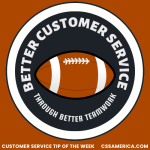In developing relationships with our clients, rarely are we truly alone. Maybe for an instant or an interaction it’s just us and the customer. But if we look longer term (a patient stay in a hospital, an account holder for a sports team, a client for a bank, a taxpayer for a municipality), those customer relationships involve many employees working together for that customer.
And in most organizations, individual good experiences don’t necessarily mean an overall good experience or lasting relationships. Sometimes the difference between Good and Great in the customer experience is driven by the handoffs between the different areas and staff. So this brings up three key questions with some quick tips noted below:
How can we ensure the NEXT employee is prepared to receive the customer prior to the “handoff?”
- Communicate between different areas of the organization about a customer and the handoff about to take place so the second employee anticipates and looks for the customer
- Bring specifics into the equation (offer background on the customer to the co-worker) – ensure the next employee can pick up on one fact about the customer so the customer feels that the handoff was made effectively
- Use names of co-workers when talking with customers about the next step to personalize the discussion and humanize the process
- Show you care about your fellow staff member in front of the customer; have a pleasant, informal dialogue with your peer so that the environment is positive and professional.
How can we “build up” the NEXT employee in the customer’s mind?
- Compliment the next staff member in front of the customer; this helps to create rapport and reduce customer anxiety about the process or the person
- Use descriptive language to describe the next staff member – “they’re energetic, successful, friendly, etc.”
- Address the credentials or experience of the next employee – “they’ve helped many people in similar situations to yours…they’ve been with us for 5 years…, etc.”
How can we check-in on the customer’s experience with the PRIOR employee?
- Ask how the process has gone so far – possibly use open-ended questions to gauge their perception of the experience
- Ask the customer how the interaction went with the prior employee; reinforce any positives they convey; offer empathy for any concerns they voice, and offer to follow-up on any issues, if appropriate.
Moving from a Good to Great customer experience can require employees to set co-workers up for success.
Enable the other employee to succeed to enhance the customer experience.





















